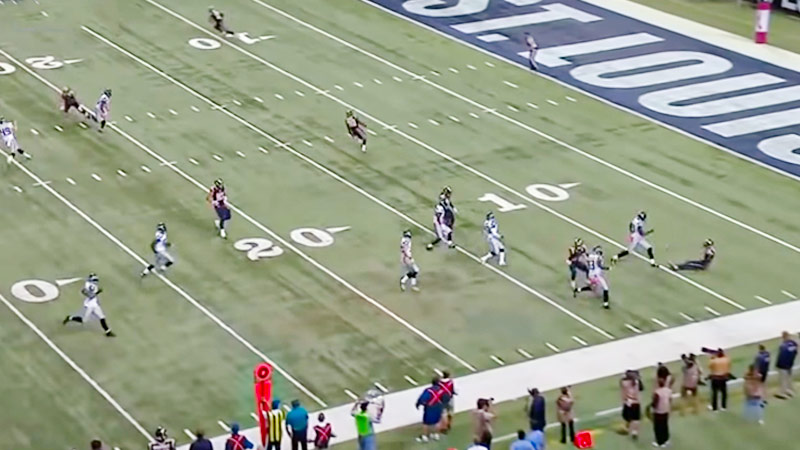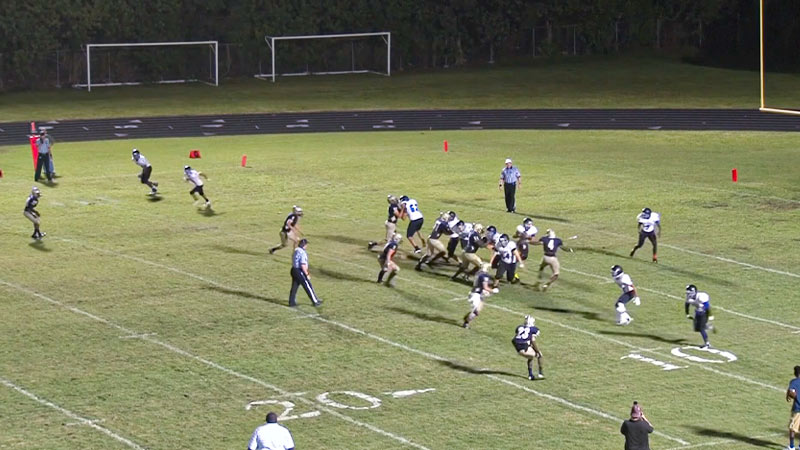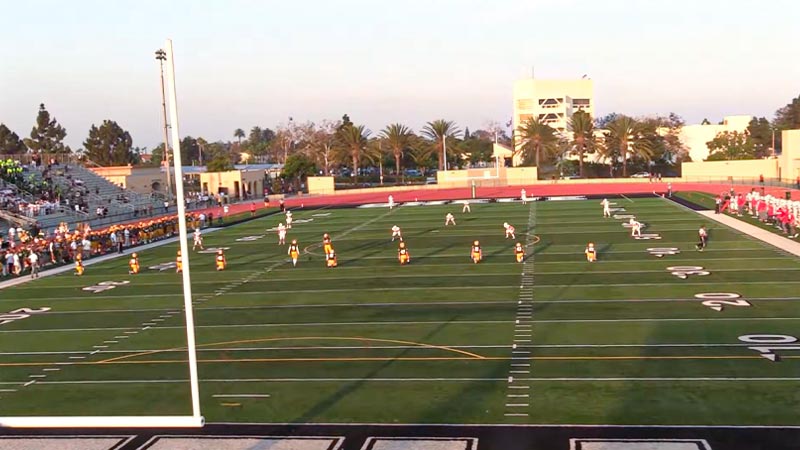In the dynamic realm of American football, the end zone is a focal point that encapsulates exhilarating moments of victory and tense defensive stands.
Whether you’re a dedicated fan or a newcomer to the sport, comprehending the intricacies of end zone rules is essential to appreciating the game’s strategy and excitement.
In this guide, we delve into frequently asked questions about end zone rules in football, shedding light on how touchdowns are scored, safeties are earned, and the role of the end zone in shaping the course of a game.
What Is An End Zone in Football?
The end zone in American football is a rectangular area located at both ends of the playing field. Each team has their own end zone that they defend and attempt to score in.
The objective is to carry or pass the ball into the opposing team’s end zone to score a touchdown, which is worth six points. The end zone is marked by a goal line at the outer edge and two sidelines extending from it.
A team’s offense advances toward the end zone to score while the defense tries to prevent them from doing so. If a player with possession of the ball crosses the goal line and enters the end zone, they score a touchdown.
Additionally, field goals can be scored by kicking the ball through the goalposts that are situated on the goal line in the end zone.
What Is Football End Zone Rules?
In American football, the end zone has several important rules associated with it:
Scoring a Touchdown
The primary objective of the offense is to carry or pass the ball into the opponent’s end zone to score a touchdown, which is worth six points. The player must have possession of the ball and cross the goal line while any part of the ball is over or inside the plane of the goal line.
Possession and Control
To score a touchdown, the player must maintain possession and control of the ball as they cross the goal line. If they drop the ball before crossing the goal line, it is considered an incomplete pass or a fumble, depending on the circumstances.
Out of Bounds
If a player carrying the ball goes out of bounds while attempting to enter the end zone, the ball is considered out of play and the play ends.
If the ball crosses the pylon (the orange markers at the corners of the end zone) while the player is in the air and out of bounds, it’s still considered a touchdown as long as they had possession and control before going out of bounds.
End Zone Catch
If a player catches the ball in the end zone and gets both feet inbounds with possession, it’s considered a touchdown. This applies to both passing plays and kicks.
Defensive Plays
The defense’s goal is to prevent the offense from entering their end zone. This can involve intercepting passes, tackling ball carriers, and defending against potential scoring plays.
Field Goals
Kicking a field goal involves attempting to kick the ball through the goalposts located on the goal line in the end zone. If successful, it results in three points for the kicking team.
Touchback
If the ball becomes dead in the end zone (for example, after a kickoff) and the receiving team doesn’t attempt to advance it out of the end zone, it’s a touchback. The ball is placed on the 25-yard line for the offense to start their possession.
These rules contribute to the excitement and strategy of American football, where both offensive and defensive teams work to utilize the end zone to their advantage.
Football End Zone Rules in the NFL

In the National Football League (NFL), the end zone rules follow the standard American football rules with a few additional specifics:
Scoring a Touchdown
A player in possession of the ball must break the plane of the goal line with any part of the ball to score a touchdown. The goal line and the pylons (orange markers) are considered part of the end zone.
End Zone Catch
For a catch to be considered a touchdown in the end zone, a receiver must have both feet (or another body part) inbounds while possessing the ball. If a receiver catches the ball and gets both feet down in the end zone, it’s a touchdown.
Out of Bounds
If a player catches the ball while airborne and crosses the sideline while landing in the end zone, it’s still a touchdown as long as they maintained possession and had both feet in bounds before going out of bounds.
Pylon Rules
If a player carrying the ball touches the pylon with the ball, it’s considered the same as touching the goal line, and if they maintain possession while doing so, it’s a touchdown.
Defensive Plays
Defensive players can intercept passes in the end zone, preventing a potential touchdown. They can also force fumbles or make tackles to prevent ball carriers from scoring.
Field Goals and Extra Points
Kicking a field goal involves attempting to kick the ball through the goalposts in the end zone. Extra points are attempted from close range after a touchdown.
Touchback
If the ball is kicked into the end zone on a kickoff, and the receiving team decides not to return it and instead kneels in the end zone or lets the ball go out of bounds, it’s a touchback. The offense then starts their possession at the 25-yard line.
Celebrations
Players often celebrate touchdowns in creative ways, sometimes involving the end zone. However, excessive celebrations can result in penalties.
These rules ensure that the end zone remains a crucial area of play, where teams strive to score touchdowns and execute strategic plays, while the defense aims to prevent those scores and create turnovers.
Touchdown and Safety in End Zone Rule

In American football, the end zone has specific rules regarding touchdowns and safeties:
Touchdown
A touchdown is scored when an offensive player carrying the ball or catching a pass crosses the opponent’s goal line and breaks the plane of the goal line with any part of the ball. This results in a score of six points for the offensive team.
Key points:
- Possession of the ball is crucial; the player must maintain control throughout the process of entering the end zone.
- If a receiver catches the ball with both feet inbounds while in the end zone, it’s also considered a touchdown.
- The pylon at the corner of the end zone is considered part of the goal line. If the ball touches the pylon, it’s equivalent to touching the goal line.
Safety
Safety is a defensive score that occurs when the offensive team is tackled or commits a foul in their own end zone. This results in two points for the defensive team, and the offensive team is also required to kick the ball to the defensive team (free kick) from their own 20-yard line.
Key points:
- To score a safety, the defense must force the ball carrier to be downed (tackled) within their own end zone.
- Safety can also occur if the offensive team commits a penalty (such as holding) in their own end zone.
- The defense can also score a safety by tackling a ball carrier who has retreated into their own end zone after receiving the ball outside of it.
The rules surrounding touchdowns and safeties are designed to encourage strategic play and create a balance between offense and defense.
Pylons and Field Goal Kick in End Zone
In American football, the pylons and field goal kicks have specific significance in the end zone:
Pylons
Pylons are small, orange markers placed at the corners of the end zone. They are used to help officials determine whether a player has scored a touchdown.
If a player carrying the ball touches the pylon with any part of their body or the ball itself, it is considered the same as touching the goal line.
If the player maintains possession while touching the pylon or breaking the plane of the goal line, it results in a touchdown.
Field Goal Kick
Field goal attempts involve kicking the football through the goalposts, which are positioned on the goal line at the back of the end zone.
If the ball passes through the goalposts above the crossbar and between the uprights, it’s a successful field goal.
A field goal is worth 3 points and can be attempted from various distances on the field. Teams usually attempt field goals when they’re in a position to score but may not be able to reach the end zone for a touchdown.
These elements play a crucial role in scoring and determining the outcome of a game, as both touchdowns and field goals contribute to a team’s total points.
Pylons aid in determining whether a player has successfully scored a touchdown, while the field goal posts define the target for successful field goal kicks in the end zone.
FAQs
What constitutes a touchdown in the end zone?
A touchdown is achieved when an offensive player crosses the opponent’s goal line with the ball in their possession, and any part of the ball breaks the plane of the goal line. The goal line extends into the end zone, making it a pivotal target for offensive plays.
How are end zone catches validated?
To be considered a touchdown, a receiver must catch the ball while having both feet (or another body part) inbounds within the end zone. This rule applies to both passes and kicks that enter the end zone.
What is safety, and how is it earned in the end zone?
A safety is scored by the defense when they tackle an offensive ball carrier in possession of the ball in their own end zone. This awards the defense two points and requires the offense to perform a free kick from their 20-yard line.
What’s the significance of the pylons in the end zone?
Pylons, those vibrant orange markers at the corners of the end zone, play a crucial role in touchdown determination.
If a player carries the ball and touches a pylon with any part of their body or the ball itself while breaking the plane of the goal line, it’s equivalent to touching the goal line itself.
How do field goal attempts factor into the end zone?
Field goal kicks are executed from the goal line, through the goalposts positioned at the back of the end zone.
If the ball sails above the crossbar and between the uprights, it’s a successful field goal, worth three points. The end zone thus serves as the backdrop for these crucial scoring attempts.
Wrapping Up
The end zone isn’t just a physical boundary; it’s a realm of strategies, athleticism, and points that determine the fate of football games.
Understanding the nuances of end zone rules enriches our viewing experience, allowing us to witness the magic of touchdowns and the tension of defensive safeties.
As players strive to reach this coveted territory, the end zone remains an emblem of triumph and a testament to the artistry of American football.
Hopefully, you have understood the points properly. Thank you for your support.







